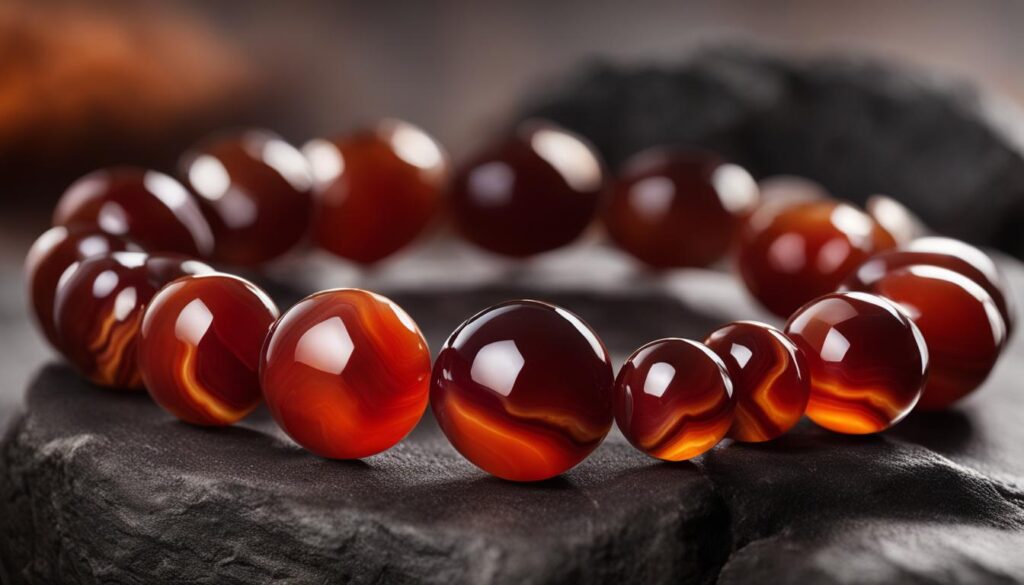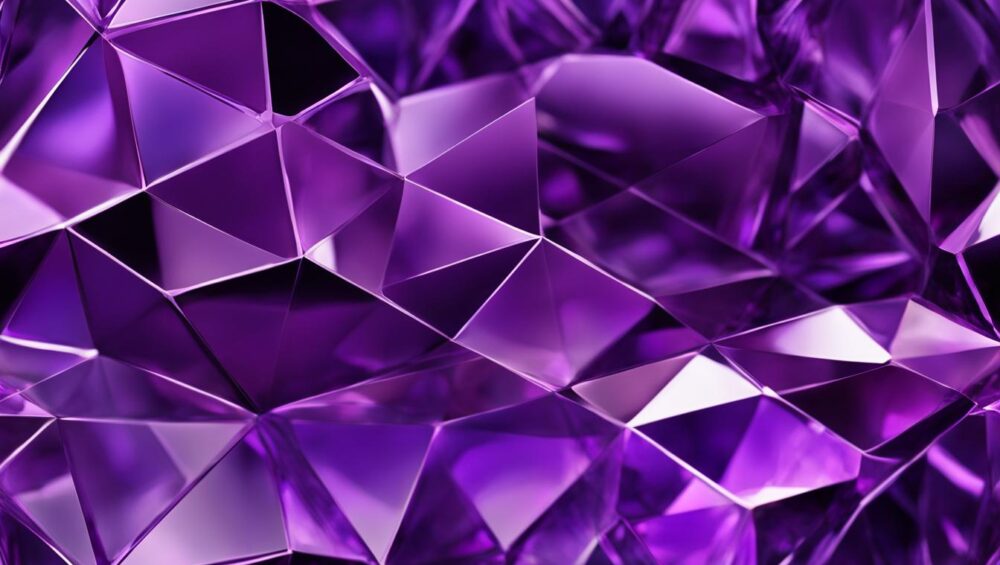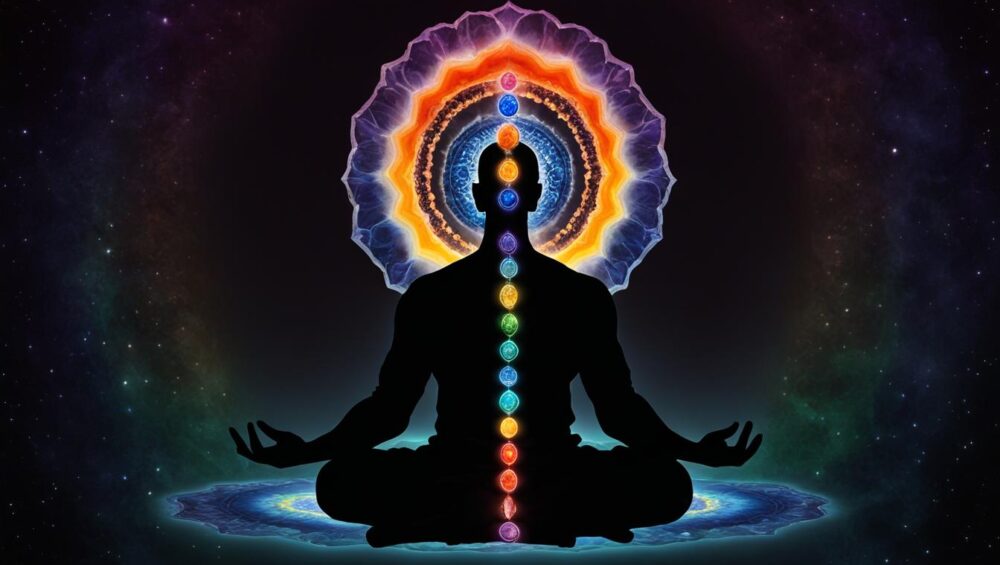Agate, a versatile and powerful healing crystal, possesses a unique ability to resonate with specific chakras in the body. By understanding the connection between agate and the chakra system, you can unlock the potential for enhanced spiritual balance and energy flow. In this guide, we will explore the different chakras and the specific chakra that agate resonates with, shedding light on the stone’s properties and metaphysical properties.
Key Takeaways:
- Agate is a powerful healing crystal that resonates with specific chakras.
- The chakra system consists of seven energy centers in the body.
- Root chakra resonates with red agate, sacral chakra resonates with orange agate, solar plexus chakra resonates with yellow agate, heart chakra resonates with green agate, and throat chakra resonates with blue agate.
- Agate can enhance spiritual balance and energy flow.
- By incorporating agate into your practice, you can promote overall well-being and healing.
Understanding the Chakra System
The chakra system is an ancient concept that originated in the Indian yogic tradition. It refers to the seven energy centers in the body, each associated with specific physical, emotional, and spiritual aspects.
The seven chakras are:
- The Root Chakra
- The Sacral Chakra
- The Solar Plexus Chakra
- The Heart Chakra
- The Throat Chakra
- The Third Eye Chakra
- The Crown Chakra
These energy centers play a vital role in maintaining our overall well-being and facilitating optimal energy flow. Balancing the chakras is essential for achieving spiritual harmony and a sense of wholeness.
Each chakra corresponds to specific areas of our life and has a unique set of characteristics. By understanding and working with the chakra system, we can address imbalances, heal energetic blockages, and cultivate a more balanced and fulfilling existence.
In the next sections, we will explore how agate resonates with each chakra, unlocking its potential for holistic healing and spiritual growth.
The Root Chakra and Agate
The root chakra, also known as the Muladhara chakra, is an energy center located at the base of the spine. It is associated with stability, grounding, and feeling connected to the Earth. When the root chakra is balanced, it promotes a sense of security and physical well-being. Agate, a type of crystal known for its vibrant colors and beautiful patterns, resonates with the root chakra and helps balance its energy.
Red agate, in particular, is a powerful crystal that enhances vitality, courage, and passion. It provides grounding and stability, making it an excellent stone for those who seek stability and strength. By working with red agate, you can activate and heal the root chakra, promoting a sense of safety, security, and energetic nourishment.
Red agate is believed to stimulate the flow of energy through the root chakra, helping to clear any blockages and restore balance. It can also help you feel more connected to the Earth, making it easier to ground yourself and find stability in your daily life. Whether you carry a red agate crystal with you, meditate with it, or place it in your environment, it can support your root chakra healing journey.

Embrace the power of red agate and let its vibrant energy guide you on your path to stability, grounding, and a deeper connection with the Earth.
The Sacral Chakra and Agate
The sacral chakra, also known as the Svadhisthana chakra, is a vital energy center associated with creativity, sensuality, and emotional well-being. When this chakra is imbalanced, it can lead to a lack of inspiration, low self-esteem, and difficulties in forming intimate connections.
Agate, a versatile and powerful crystal, can resonate with the sacral chakra, especially in the form of vibrant orange crystals. Orange agate crystals possess unique properties that enhance vitality, passion, and sexual energy, allowing for greater creativity and emotional pleasure.
By working with agate and focusing its energy on the sacral chakra, you can restore balance and activate this important energy center. Agate helps to clear blockages, release stagnant emotions, and stimulate the flow of creative ideas. It supports personal growth and emotional expression, giving you the confidence to explore your creative pursuits and indulge in sensuality.
“Agate has the remarkable ability to spark creativity and ignite the fire within, bringing forth inspiration and allowing one to express their true self with confidence and passion.”
Whether you are an artist seeking artistic inspiration or someone looking to embrace their sensuality, incorporating agate into your practice can have transformative effects on your sacral chakra. By harnessing the power of orange agate crystals, you can tap into your inner creativity, explore your sensuality, and experience a deeper connection with your emotions.

| Agate Type |
Properties |
| Orange Agate |
Enhances vitality and passion
Stimulates creativity and sensuality
Supports emotional pleasure and expression |
The Solar Plexus Chakra and Agate
The solar plexus chakra, also known as the Manipura chakra, is associated with personal power, self-confidence, and identity. Agate can resonate with the solar plexus chakra, particularly yellow agate crystals. These crystals enhance creativity, willpower, and mental clarity, allowing for greater self-expression and manifestation of goals. By incorporating agate into your practice, you can balance and activate the solar plexus chakra, fostering a sense of empowerment and personal growth.
Benefits of Yellow Agate for the Solar Plexus Chakra
Yellow agate crystals offer a range of benefits when it comes to balancing and activating the solar plexus chakra:
| Benefits of Yellow Agate for the Solar Plexus Chakra |
| Enhances creativity |
| Boosts willpower |
| Improves mental clarity |
| Supports self-expression |
| Aids in manifestation of goals |
Yellow agate crystals stimulate the solar plexus chakra, empowering you to tap into your inner strength and self-confidence. With their vibrant energy, they help you unleash your creative potential, overcome obstacles, and take charge of your life. By utilizing yellow agate in your spiritual practice, you can activate the solar plexus chakra, leading to a greater sense of empowerment and personal growth.
The Heart Chakra and Agate
The heart chakra, also known as the Anahata chakra, is a vital energy center associated with love, compassion, and connection. It is the bridge between the lower and higher chakras, holding the power to heal and harmonize relationships, both with oneself and others.
Agate, a mesmerizing crystal, resonates profoundly with the heart chakra, offering its soothing energy and vibrant green hues. Green agate crystals hold a special place in the realm of heart-centered healing, as they enhance the qualities of love, compassion, and emotional well-being.
When working with green agate, one can experience remarkable healing, inner growth, and a renewed sense of abundance. These crystals have the power to open the heart chakra, allowing love to flow freely and unconditionally. They nurture deep connections, whether in romantic relationships, friendships, or even the love for oneself.
“Love and compassion are necessities, not luxuries. Without them, humanity cannot survive.” – Dalai Lama
Green agate stimulates healing on all levels, bringing about a positive transformation in one’s perspective towards the world. Its gentle energy helps release emotional blockages, promoting emotional healing and nurturing a positive self-image.
By incorporating green agate into your spiritual practice, you can balance and activate the heart chakra, creating a harmonious flow of love and compassion. Whether through meditation, crystal grids, or simply carrying a piece of green agate close to your heart, its energy will support you in cultivating a deep sense of love and compassion for yourself and others.
Heart Chakra and Agate Healing Properties:
| Chakra |
Agate |
| Heart Chakra |
Green Agate |
The Throat Chakra and Agate
The throat chakra, also known as the Vishuddha chakra, is responsible for clear communication, self-expression, and authenticity. It plays a vital role in our ability to effectively express our thoughts and emotions.
Clearing and balancing the throat chakra is crucial for maintaining healthy communication and fostering harmonious relationships. When the throat chakra is imbalanced, you may experience difficulties in expressing yourself, fear of judgment, or even physical manifestations like throat issues or uing sensations. Agate, especially blue agate crystals, can help restore balance to the throat chakra and promote fluent communication.
Blue agate crystals have a calming and soothing energy that encourages open and honest communication. These crystals enhance clarity, confidence, and emotional release, allowing you to express your thoughts and feelings with clarity and authenticity. By incorporating blue agate into your chakra healing practice, you can activate and harmonize the throat chakra, which supports effective communication and self-expression.
Whether you are struggling to find your voice, speaking in public, or expressing your true self, blue agate crystals can assist you in finding the strength and confidence to communicate your thoughts and emotions. They facilitate self-expression without fear or hesitation, allowing you to speak your truth and be heard.
Affirmations for the Throat Chakra:
- “I express my thoughts and emotions with clarity and confidence.”
- “I speak my truth and communicate authentically.”
- “I communicate effectively and positively influence others.”
By practicing affirmations and integrating blue agate crystals into your daily routine, you can nurture and heal your throat chakra, creating a foundation for clear and authentic communication in all aspects of your life.
Conclusion
Agate is a powerful crystal for chakra healing and spiritual balance. By understanding which chakra agate resonates with, you can incorporate it into your practice to enhance energy flow and promote overall well-being. Whether you choose red agate for the root chakra, orange agate for the sacral chakra, yellow agate for the solar plexus chakra, green agate for the heart chakra, blue agate for the throat chakra, or other variants, agate has the potential to bring harmony and healing to your spiritual journey.
Agate’s metaphysical properties and color variations make it a versatile stone that can support and align each of the seven chakras. Its vibrational energy can help balance and activate the specific energy centers in your body, allowing for a smoother flow of energy and facilitating emotional, physical, and spiritual healing. By working with agate, you can experience a greater sense of spiritual balance and an enhanced connection to your inner self.
Embrace the power of agate and discover the transformative effects it can have on your energy centers. Incorporate agate into your daily meditation, wear it as jewelry, or place it on the corresponding chakra during a healing session. Allow the vibrations of agate to penetrate and harmonize your energy, bringing you closer to a state of spiritual balance, vitality, and well-being.
FAQ
What is the chakra system?
The chakra system is an ancient concept that originated in the Indian yogic tradition. It refers to the seven energy centers in the body, each associated with specific physical, emotional, and spiritual aspects.
How many chakras are there?
There are seven chakras in the chakra system. They are the root, sacral, solar plexus, heart, throat, third eye, and crown chakras. Each chakra has its own unique characteristics and significance.
Which chakra does agate resonate with?
Agate resonates with different chakras based on its color. Red agate resonates with the root chakra, orange agate resonates with the sacral chakra, yellow agate resonates with the solar plexus chakra, green agate resonates with the heart chakra, and blue agate resonates with the throat chakra.
How does agate affect the root chakra?
Agate, particularly red agate, enhances vitality, courage, and passion while providing grounding and stability. By working with red agate, you can balance and heal the root chakra, promoting a sense of safety, security, and energetic nourishment.
What impact does agate have on the sacral chakra?
Agate, especially orange agate crystals, enhances vitality, passion, and sexual energy, allowing for greater creativity and emotional pleasure. By incorporating orange agate into your practice, you can balance and activate the sacral chakra, supporting personal growth and emotional expression.
How does agate influence the solar plexus chakra?
Agate, particularly yellow agate crystals, enhances creativity, willpower, and mental clarity, allowing for greater self-expression and manifestation of goals. By incorporating yellow agate into your practice, you can balance and activate the solar plexus chakra, fostering a sense of empowerment and personal growth.
What impact does agate have on the heart chakra?
Agate, especially green agate crystals, enhances healing, abundance, and inner growth, promoting a positive view of the world and fostering deep love and compassion. By working with green agate, you can balance and activate the heart chakra, supporting emotional healing and harmonious relationships.
How does agate influence the throat chakra?
Agate, particularly blue agate crystals, enhances clarity, confidence, and emotional release, allowing for clear and authentic communication. By incorporating blue agate into your practice, you can balance and activate the throat chakra, supporting effective communication and self-expression.
Can agate be used for chakra healing?
Yes, agate is a powerful tool for chakra healing and spiritual balance. By understanding which chakra agate resonates with, you can incorporate it into your practice to enhance energy flow and promote overall well-being.
Source Links






